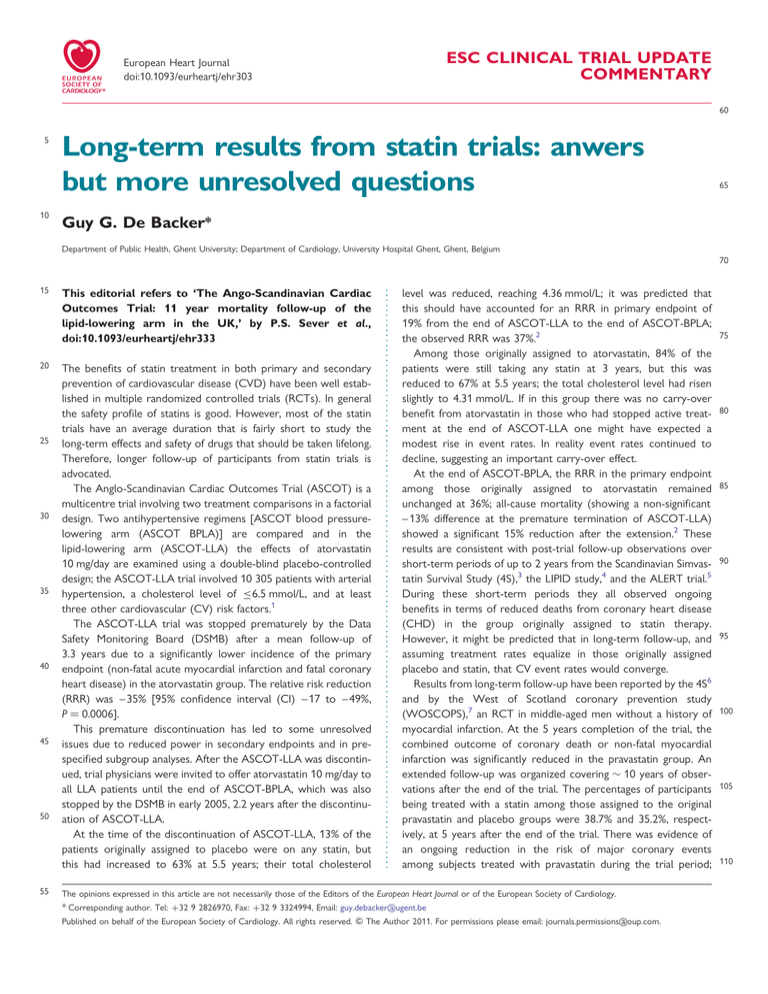
ESC CLINICAL TRIAL UPDATE
COMMENTARY
European Heart Journal
doi:10.1093/eurheartj/ehr303
60
5
10
Long-term results from statin trials: anwers
but more unresolved questions
65
Guy G. De Backer*
Department of Public Health, Ghent University; Department of Cardiology, University Hospital Ghent, Ghent, Belgium
70
15
20
25
30
35
40
45
50
55
This editorial refers to ‘The Ango-Scandinavian Cardiac
Outcomes Trial: 11 year mortality follow-up of the
lipid-lowering arm in the UK,’ by P.S. Sever et al.,
doi:10.1093/eurheartj/ehr333
The benefits of statin treatment in both primary and secondary
prevention of cardiovascular disease (CVD) have been well established in multiple randomized controlled trials (RCTs). In general
the safety profile of statins is good. However, most of the statin
trials have an average duration that is fairly short to study the
long-term effects and safety of drugs that should be taken lifelong.
Therefore, longer follow-up of participants from statin trials is
advocated.
The Anglo-Scandinavian Cardiac Outcomes Trial (ASCOT) is a
multicentre trial involving two treatment comparisons in a factorial
design. Two antihypertensive regimens [ASCOT blood pressurelowering arm (ASCOT BPLA)] are compared and in the
lipid-lowering arm (ASCOT-LLA) the effects of atorvastatin
10 mg/day are examined using a double-blind placebo-controlled
design; the ASCOT-LLA trial involved 10 305 patients with arterial
hypertension, a cholesterol level of ≤6.5 mmol/L, and at least
three other cardiovascular (CV) risk factors.1
The ASCOT-LLA trial was stopped prematurely by the Data
Safety Monitoring Board (DSMB) after a mean follow-up of
3.3 years due to a significantly lower incidence of the primary
endpoint (non-fatal acute myocardial infarction and fatal coronary
heart disease) in the atorvastatin group. The relative risk reduction
(RRR) was –35% [95% confidence interval (CI) –17 to –49%,
P ¼ 0.0006].
This premature discontinuation has led to some unresolved
issues due to reduced power in secondary endpoints and in prespecified subgroup analyses. After the ASCOT-LLA was discontinued, trial physicians were invited to offer atorvastatin 10 mg/day to
all LLA patients until the end of ASCOT-BPLA, which was also
stopped by the DSMB in early 2005, 2.2 years after the discontinuation of ASCOT-LLA.
At the time of the discontinuation of ASCOT-LLA, 13% of the
patients originally assigned to placebo were on any statin, but
this had increased to 63% at 5.5 years; their total cholesterol
level was reduced, reaching 4.36 mmol/L; it was predicted that
this should have accounted for an RRR in primary endpoint of
19% from the end of ASCOT-LLA to the end of ASCOT-BPLA;
the observed RRR was 37%.2
Among those originally assigned to atorvastatin, 84% of the
patients were still taking any statin at 3 years, but this was
reduced to 67% at 5.5 years; the total cholesterol level had risen
slightly to 4.31 mmol/L. If in this group there was no carry-over
benefit from atorvastatin in those who had stopped active treatment at the end of ASCOT-LLA one might have expected a
modest rise in event rates. In reality event rates continued to
decline, suggesting an important carry-over effect.
At the end of ASCOT-BPLA, the RRR in the primary endpoint
among those originally assigned to atorvastatin remained
unchanged at 36%; all-cause mortality (showing a non-significant
– 13% difference at the premature termination of ASCOT-LLA)
showed a significant 15% reduction after the extension.2 These
results are consistent with post-trial follow-up observations over
short-term periods of up to 2 years from the Scandinavian Simvastatin Survival Study (4S),3 the LIPID study,4 and the ALERT trial.5
During these short-term periods they all observed ongoing
benefits in terms of reduced deaths from coronary heart disease
(CHD) in the group originally assigned to statin therapy.
However, it might be predicted that in long-term follow-up, and
assuming treatment rates equalize in those originally assigned
placebo and statin, that CV event rates would converge.
Results from long-term follow-up have been reported by the 4S6
and by the West of Scotland coronary prevention study
(WOSCOPS),7 an RCT in middle-aged men without a history of
myocardial infarction. At the 5 years completion of the trial, the
combined outcome of coronary death or non-fatal myocardial
infarction was significantly reduced in the pravastatin group. An
extended follow-up was organized covering 10 years of observations after the end of the trial. The percentages of participants
being treated with a statin among those assigned to the original
pravastatin and placebo groups were 38.7% and 35.2%, respectively, at 5 years after the end of the trial. There was evidence of
an ongoing reduction in the risk of major coronary events
among subjects treated with pravastatin during the trial period;
The opinions expressed in this article are not necessarily those of the Editors of the European Heart Journal or of the European Society of Cardiology.
* Corresponding author. Tel: +32 9 2826970, Fax: +32 9 3324994, Email: guy.debacker@ugent.be
Published on behalf of the European Society of Cardiology. All rights reserved. & The Author 2011. For permissions please email: journals.permissions@oup.com.
75
80
85
90
95
100
105
110
Page 2 of 2
115
120
125
130
135
140
145
150
155
160
the authors consider it as an ongoing carry-over effect related to a
slowing of the progression of the disease and/or a stabilization of
existing plaques.
The authors of the 4S study reported on an extended 5 year
follow-up of deaths and incident cancers.6 During the 5 year
extension . 80% of patients in both groups were treated with
lipid-lowering drugs. They found that the survival benefit of
patients originally assigned to simvastatin compared with the
placebo group persisted during follow-up; the absolute differences
in all-cause, CV, and coronary mortality achieved during the
double-blind trial changed little during the 5 year extension of
the follow-up; the reduction in the relative risk between the two
original treatment groups was ascribed to the open-label treatment with lipid-lowering drugs of most of the patients in both
groups when the trial ended; there was no evidence of a difference
in incident cancers.
Results have now been presented from a 11 year mortality
follow-up of the participants recruited in ASCOT-LLA in the
UK,8 representing 45% of the whole ASCOT-LLA study population; comparisons with previous reports from ASCOT-LLA are
difficult: the baseline characteristics of the UK participants are
different in various respects compared with those of the whole
ASCOT-LLA groups; only results on mortality follow-up are
given; therefore, only two out of the eight primary and secondary
endpoints of ASCOT-LLA can be examined. For the interpretation
of the results, one would like to know the proportions of
participants on continuous lipid-lowering drug treatment
throughout the extension period, but this is not available.
In the whole ASCOT-LLA trial, CV mortality was not significantly different between the atorvastatin and the placebo groups
at the premature closure of the trial ( –14%; 95% CI –37 to
+45) or after the 2 year extension ( –12%; 95% CI –27 to
+32). In the UK cohort, CV mortality was non-significantly
reduced by –17% (95% CI –49 to +35) at the end of the
LLA trial and this became –11% (95% CI –29 to +11) after
11 years. These results are in line with what was observed in the
long-term follow-up of the 4S study.
More surprising are the results of total mortality. Similarly to
what was seen in the whole ASCOT-LLA, total mortality was
not significantly different at the end of the LLA trial between the
atorvastatin and the placebo group in the UK subgroup; the difference became significant at the closure of ASCOT-BPLA at 5 years,
and in the UK group the difference remained significant at the end
of the 11 years of follow-up. Since CV mortality went in the opposite direction, one expects a trend in favour of the group originally
assigned to atorvastatin in non-CV mortality, and this was the case.
The large majority of non-CV mortality is due to cancer deaths
(66 and 60%, respectively, of all non-CV deaths in the groups originally assigned to atorvastatin and to placebo). The difference in
cancer mortality rates was not different between the two groups
Commentary
at any point in time, and this is reassuring and confirms
observations in WOSCOPS and 4S.
Post-hoc analysis of other non-CV mortality causes of death
revealed significant differences in deaths due to infections/respiratory disease during the extension period, resulting in a hazard ratio
of 0.64 (95% CI 0.42–0.97) for the total 11 year period. An
explanation for these long-term benefits on non-CV deaths is
not available, but results from observational studies9,10 are congruent and suggest that statins may have a therapeutic role through
pleiotropic effects in the management of pneumonia and sepsis,
although an explanation for a long-term carry-over effect has not
been established. Different unintended benefits and adverse
effects of statins have been suggested; this needs further studies,
preferably in RCTs, but also re-emphasizes the need for long-term
pharmaco-surveillance.
175
180
185
Conflict of interest: none declared.
References
1. Sever PS, Dahlof B, Poulter NR, Wedel H, Beevers G, Caulfield M, Collins R,
Kjeldsen SE, Kristinsson A, McInnes GT, Mehlsen J, Nieminen M, O’Brien E,
Ostergren J for the ASCOT Investigators. Prevention of coronary and stroke
events with atorvastatin in hypertensive patients who have average or
lower-than-average cholesterol concentrations, in the Anglo-Scandinavian
Cardiac Outcomes Trial-Lipid Lowering arm (ASCOT-LLA): a multicentre
randomized controlled trial. Lancet 2003;361:1149 –1158.
2. Sever PS, Poulter NR, Dahlof B, Wedel H, Beevers G, Caulfield M, Collins R,
Kjeldsen SE, Kristinsson A, McInnes G, Mehlsen J, Nieminen MS, O’Brien E,
Ostergren J. on behalf of the ASCOT investigators. The Anglo-Scandinavian
Cardiac Outcomes trial lipid lowering arm: extended observations 2 year after
trial closure. Eur Heart J 2008;29:499 –508.
3. Pedersen TR, Wilhelmsen L, Faergeman O, Strandberg TE, Thorgeirsson G,
troedsson L, Kristianson J, berg K, Cook TJ, Haghfelt T, Kjekshus J, Miettinen T,
Olsson AG, Pyörälä K, Wedel H on behalf of the Scandinavian Simvastatin Survival
Study Group. Follow-up study of patients randomized in the Scandinavian Simvastatin Survival Study (4S) of cholesterol lowering. Am J Cardiol 2000;86:257 –262.
4. The LIPID Study Group. Long-term effectiveness and safety of pravastatin in 9014
patients with coronary heart disease and average cholesterol concentrations: the
LIPID trial follow-up. Lancet 2002;359:1379 –1387.
5. Holdaas H, Fellstrom B, Cole E, Nyberg G, Olsson AG, Pedersen TR, Madsen S,
Gronhagen-Riska C, Neumayer HH, Maes B, Ambuhl P, Hartmann A, Staffler B,
Jardine AG. Long-term cardiac outcomes in renal transplant recipients receiving
fluvastatin: the ALERT extension study. Am J Transplant 2005;5:2929 – 2936.
6. Strandberg TE, Pyörälä K, Cook TJ, Wilhelmsen L, Faergeman O, Thorgeirsson G,
Pedersen TR, Kjekshus J for the 4S Group. Mortality and incidence of cancer
during 10-year follow-up of the Scandinavian Simvastatin Survival Study (4S).
Lancet 2004;364:771 –777.
7. Ford I, Murray H, Packard CJ, Shepherd J, Macfarlane PW, Cobbe SM, for the
West of Scotland Coronary Prevention Study Group. Long-term follow-up of
the West of Scotland Coronary Prevention study. N Engl J Med 2007;357:
1477 –1486.
8. Sever PS, Chang CL, Gupta AK, Whitehouse A, Poulter NR, on behalf of the
ASCOT Investigators. The Anglo-Scandinavian Cardiac Outcomes Trial: 11 year
mortality follow-up of the lipid-lowering arm in the UK. Eur Heart J
doi:10.1093/eurheartj/ehr333
9. Chalmers JD, Short PM, Mandal P, Akram AR, Hill AT. Statins in community
acquired pneumonia: evidence from experimental and clinical studies. Respir
Med 2010;104:1081 –1091.
10. Douglas I, Evans S, Smeeth L. Effect of statin treatment on short term mortality
after pneumonia episode: cohort study. BMJ 2011;342:doi:10.1136/bmj.d1642.
190
195
200
205
210
215
220
165
225
170

